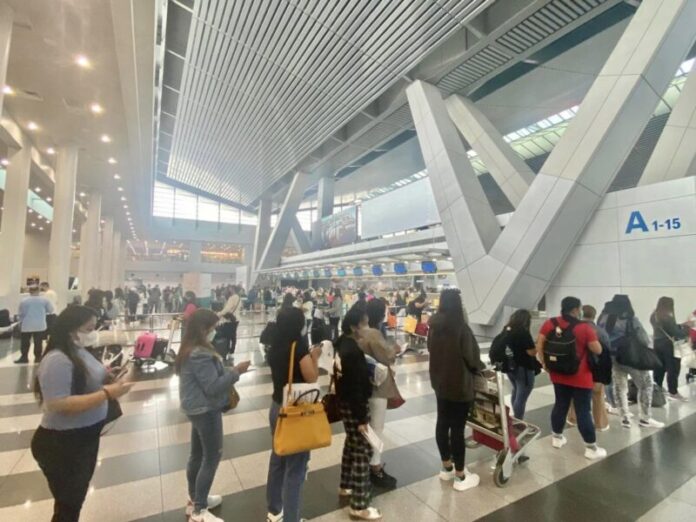
-
The Civil Aviation Authority of the Philippines said its air traffic control system is now “running smoothly” and contingencies are in place following the January 1 technical glitch that cancelled hundreds of flights in the country
-
CAAP deputy director general for operations Capt. Edgardo Diaz said “material failure” is currently seen as the most likely cause of the incident but the ongoing investigation is still looking at all possibilities
-
Contingency procedures are now in place with people on standby and more frequent monitoring of the CNS/ATM system being conducted
The Civil Aviation Authority of the Philippines (CAAP) said its air traffic control system is now “running smoothly” and contingencies are in place following the January 1 outage that cancelled hundreds of flights in the country.
“For the past several days after we have fixed the problem, the CNS/ATM (communications, navigation, surveillance/air traffic management system) is running smoothly,” CAAP deputy director general for operations Edgardo Diaz said in an interview with ANC on January 5.
Diaz said “just in case something goes wrong, just like what happened in January 1, contingency procedures are now in place” with people on standby and more frequent monitoring of the CNS/ATM system being conducted.
He added that the ground-based communications system is in place and augmented with personnel “so that they will be ready to accept flights even if the CNS/ATM is not working.”
Diaz said they are still conducting an internal investigation, which would take time, on what had caused the January 1 power outage of the CNS/ATM system that affected flights in various airports in the country, including major gateways. The system resumed normal operations on the same day at 5:50 p.m.
CAAP’s Aerodrome and Air Navigation Safety Oversight Office (AANSOO) has been tasked to investigate the incident. AANSOO is composed of CAAP technical personnel such as aerodrome engineers, electrical and communication engineers, Air traffic controllers, pilots and a lawyer.
Diaz said “material failure” is currently seen as the most likely cause of the incident and that the uninterrupted power supply (UPS), which did not go online as it was supposed to during the power outage, is “now the center” of the investigation.
“What we see right now and according to our engineers is that it is most likely a material failure,” Diaz said.
He noted, however, that they are not ruling out other possibilities such as sabotage, cybercrime, and negligence.
Diaz also said preventive maintenance “is being carried out religiously everyday” on the CNS/ATM system and that it “did not show any abnormality at the time.”
He added that prior to the incident and early when they assumed office last year, CAAP officials have already informed Transportation Secretary Jaime Bautista of the need for a new CNS/ATM system or a backup system, noting that the existing system “could be a potential problem.”
CAAP acting director general Antonio Manuel Tamayo earlier said the CNS/ATM is “outdated”. Bautista also said they have already informed President Ferdinand Marcos Jr. of the need for a backup system.
Various agencies have agreed in a January 3 briefing that an upgrade of CAAP’s existing facilities and replacement of affected equipment is the immediate course of action.
Jan 12 Senate probe
Meanwhile, Diaz said they are ready for a Senate inquiry into the January 1 air traffic control technical glitch.
The Senate Committee on Public Services will start the inquiry on Jan. 12, Senator Grace Poe announced Wednesday.
Also on Wednesday, San Jose del Monte City Representative Florida Robes filed a resolution asking the House leadership to direct the House Committee on Good Government and Public Accountability to conduct an inquiry on malfunction.
Bagong Henerasyon Party-list Rep. Bernadette Herrera, for her part, said the recent air traffic system fiasco affected not just passengers but also several tons of cargo, incoming and outgoing, which would have lingering effects on businesses and the economy.
The Governance Commission for GOCCs (GCG), meantime, directed CAAP to submit a report on the circumstances surrounding the incident. CAAP is a government-owned and operated corporation (GOCC) that is under the jurisdiction of the GCG.
CAAP’s CNS/ATM, which was completed in 2017 and inaugurated in January 2018, is a state-of-the art computer and satellite-based air traffic management technology similar to those in use in Australia, Taiwan, and European countries. It started comprehensive operations in July 2019.
RELATED READ: New air traffic management system elevates PH air traffic safety, efficiency
The CNS/ATM project started in 2009 but due to delay in construction and other challenges, it did not hit its target completion date in 2016.
The project was funded by the Japan International Cooperation Agency for JPY22 million (US$198 million) and includes a central traffic control complex housed in the CAAP office in Manila.




